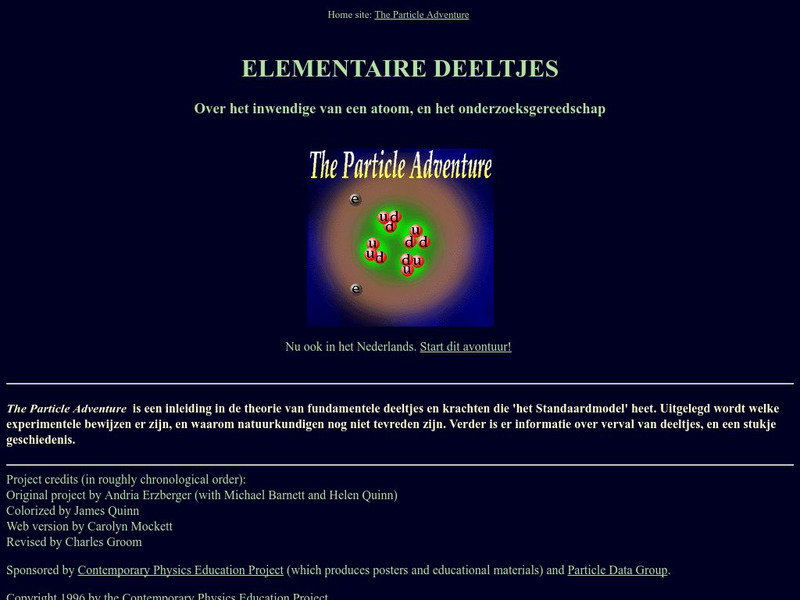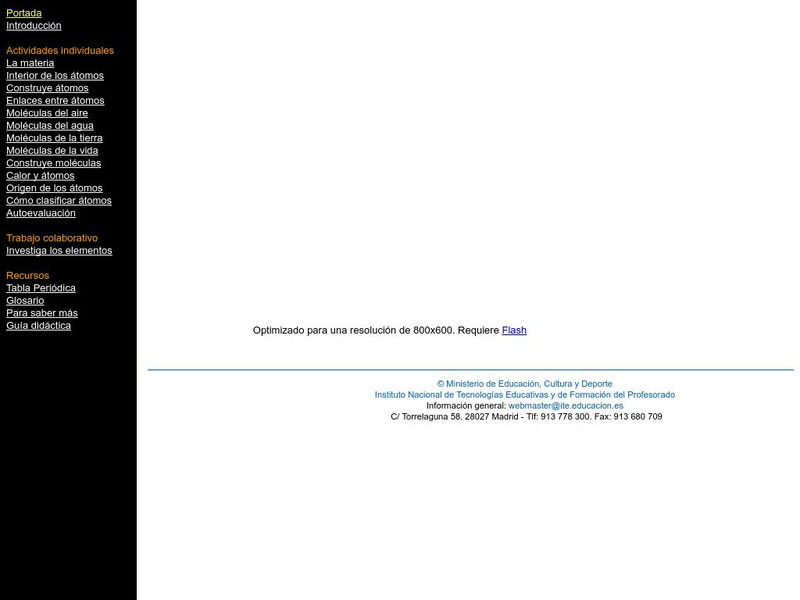Hi, what do you want to do?
OpenStax
Open Stax: Structural Organization of the Human Body
Try considering the structures of the body in terms of fundamental levels of organization that increase in complexity: subatomic particles, atoms, molecules, organelles, cells, tissues, organs, organ systems, organisms and biosphere....
CK-12 Foundation
Ck 12: Fifth Grade Science: Physical Science: Types of Matter
[Free Registration/Login may be required to access all resource tools.] Discusses elements, atoms, compounds, molecules, and crystals. Looks at mixture and different types of them.
Nobel Media AB
The Nobel Prize: Chirality Chemistry 2001
In 2001 the Nobel prize in chemistry was awarded for work with Chiral molecules. These molecules can be used to control the speed of chemical reactions. This brief game teaches the basic principles of chirality.
Wikimedia
Wikipedia: Ion
This site is an encyclopedia article from the Wikipedia Encyclopedia on Ion. Throughout the site, links are provided for additional information. The information is somewhat in-depth, but also very factual and interesting.
Other
Particle Adventure Dutch Version
Dutch version of the well-known "Particle Adventure" physics website that teaches students about atoms, mass, particle physics, and quantum physics. The site discusses theories related to physics and provides other links related to the...
Simon Fraser University
Chem1 Virtual Textbook: Chemical Composition
Chemical composition is a section of a larger overview on Chemistry, covering a variety of aspects. This section focuses on elements, atoms, compounds, and structure. Examples, formulas, and pictures are provided.
Ministerio de Educación (Spain)
Ministerio De Educacion: Viaje Al Interior De La Materia
These interactive materials will help you to understand how matter is made up and will help you expand your knowledge on matter. You will find an evaluation at the end.
Other
Beautiful Chemistry: Beautiful Structures: Quasicrystals
An interactive display of quasicrystals allows students to study the inner components and molecular make-up of these structures. Since the discovery of quasicrystals, a lot of efforts have been put on finding the locations of atoms...
Science Education Resource Center at Carleton College
Serc: Plastic Polymers: Investigating Their Flexibility
Students will use their prior knowledge about changes of matter to develop a hypothesis to test the physical properties of materials such as plastic (polymers) and how its chemical properties allow it to have unique physical properties.
Curated OER
Science Kids: Science Images: 3 D Carbon Monoxide Molecule
This is a computer generated 3D image of a carbon monoxide molecule. Carbon monoxide contains one carbon atom and one oxygen atom. It is an odorless gas that is highly toxic to humans.
Utah STEM Foundation
Utah Stem Action Center: Smoke in a Bottle
Students will learn how complete and incomplete combustion is different and also how the products affect us.
Science Buddies
Science Buddies: Study Chirality With a Homemade Polarimeter
Some molecules can be either left- or right-"handed." The left- and right-handed molecules have the same number and type of atoms, and their chemical structures look identical, but they are actually mirror images of each other. Many...
American Chemical Society
Middle School Chemistry: What Is Density?
Calculate the density of cubes made of different materials to determine what type of material it contains. Using this information explain that the size, mass, and arrangement of the atoms or molecules of a substance determines its density.
ClassFlow
Class Flow: What Is Matter?
[Free Registration/Login Required] Discover the composition of matter and the relationship between matter, atoms, and elements. Students will learn the differences between elements and compounds, and how molecules are formed. Chemical...
Georgia Department of Education
Ga Virtual Learning: Ap Biology: Chemistry of Life
Through informational text, interactive activities, animations, and video clips, students examine the chemistry of living things, and they learn how interactions from atoms are fundamental to life as we know it.
PBS
Pbs Learning Media: Chemical Bonds
This interactive activity developed for Teachers' Domain demonstrates how attractive forces between atoms create chemical bonds, resulting in the formation of molecules and compounds.
Nobel Media AB
The Nobel Prize: The Nobel Prize in Chemistry 1934
At this website from The Nobel e-Museum, read about Harold Clayton Urey (1893-1981 CE), the chemist awarded with a Nobel Prize "for his discovery of heavy hydrogen." Download Urey's Nobel Lecture, "Some thermodynamic properties of...
Concord Consortium
Concord Consortium: Stem Resources: Chemical Bonds
By working through this web-based activity, students differentiate between ionic, non-polar covalent, and polar covalent bonds. Specifically, distinctions are made between bonding types based on orbital shapes and electronegativity...
National Institutes of Health
Ncbi: The Molecular Biology of the Cell: The Chemical Components of a Cell
Advanced chapter of the book "The Molecular Biology of the Cell" describes and provides illustrations of our most current understanding of the chemical makeup of cells and their components. Explains in detail how electron activity keeps...
Concord Consortium
Concord Consortium: How Can a Small Spark Start a Huge Explosion?
Students explore connections between electric forces and molecules using simulations, and explain energy transfers using conservation of energy. This concept will be explored in the following activities. Activity 1 What makes materials...
University Corporation for Atmospheric Research
Ucar: Nitrogen Oxides
Learn interesting facts about nitrogen oxides, gases whose molecules are made of nitrogen and oxygen atoms and contribute to air pollution.
Curated OER
Simon Fraser University: Molecules and the Properties of Bonded Atoms
Water molecule, complete with coordinates.
Curated OER
Simon Fraser University: Molecules and the Properties of Bonded Atoms
Drawing of sucrose molecule -- table sugar. Colors show negative electrical potential on its molecular surface.
Curated OER
Simon Fraser University: Molecules and the Properties of Bonded Atoms
Drawing of a caffeine molecule. Hydrogen = white; Carbon = blue; Oxygen = red
Other popular searches
- Gumdrop Atoms and Molecules
- Making Atoms and Molecules
- Science, Atoms and Molecules
- Science Atoms and Molecules
- Atoms and Molecules Lesson
- Atoms and Molecules Musical
- Combining Atoms and Molecules
- Molecules and Atoms
- Atoms Molecules and Element
- Courting Atoms and Molecules
- Elements Molecules and Atoms
















